1994 CHEVROLET S10 warning light
[x] Cancel search: warning lightPage 165 of 340
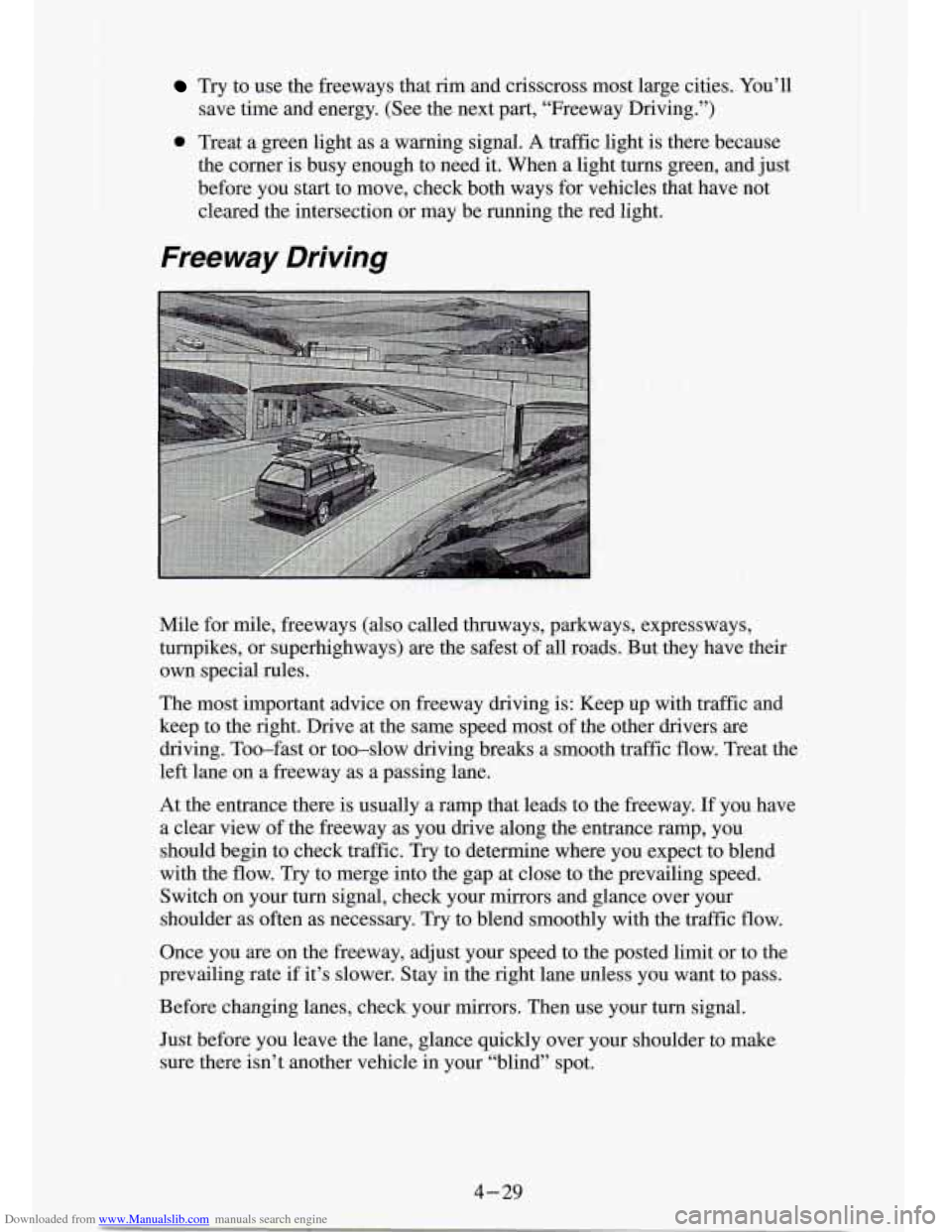
Downloaded from www.Manualslib.com manuals search engine Try to use the freeways that rim and crisscross most large cities. You’ll
save time and energy. (See the next part, “Freeway Driving.”)
0 Treat a green light as a warning signal. A traffic light is there because
the corner is busy enough to need it. When a light turns green, and just
before you start to move, check both ways for vehicles that have not
cleared
the intersection or may be running the red light.
Freeway Driving
Mile for mile, freeways (also called thruways, parkways, expressways,
tumplkes, or superhighways) are the safest
of all roads. But they have their
own special rules.
The most important advice on freeway driving is: Keep up with
traffic and
keep to the right. Drive at the
same speed most of the other drivers are
driving. Too-fast or too-slow driving breaks a smooth traffic flow. Treat the
left lane on a freeway as a passing lane.
At the entrance there is usually a ramp that leads to the freeway. If you have
a clear view of the freeway as you drive along the entrance ramp, you
should begin to check traffic. Try to determine where you expe\
ct to blend
with the flow. Try to merge into the gap at close to the prevailing s\
peed.
Switch on your turn signal, check your mirrors and glance over your
shoulder
as often as necessary. Try to blend smoothly with the traffic flow.
Once you are on the freeway, adjust
your speed to the posted limit or to the
prevailing rate
if it’s slower. Stay in the right lane unless you want to pass.
Before changing lanes, check your mirrors. Then use your turn signal.
Just before you leave the lane, glance quickly over your shoulder t\
o make
sure there isn’t another vehicle
in your “blind” spot.
4-29
Page 169 of 340
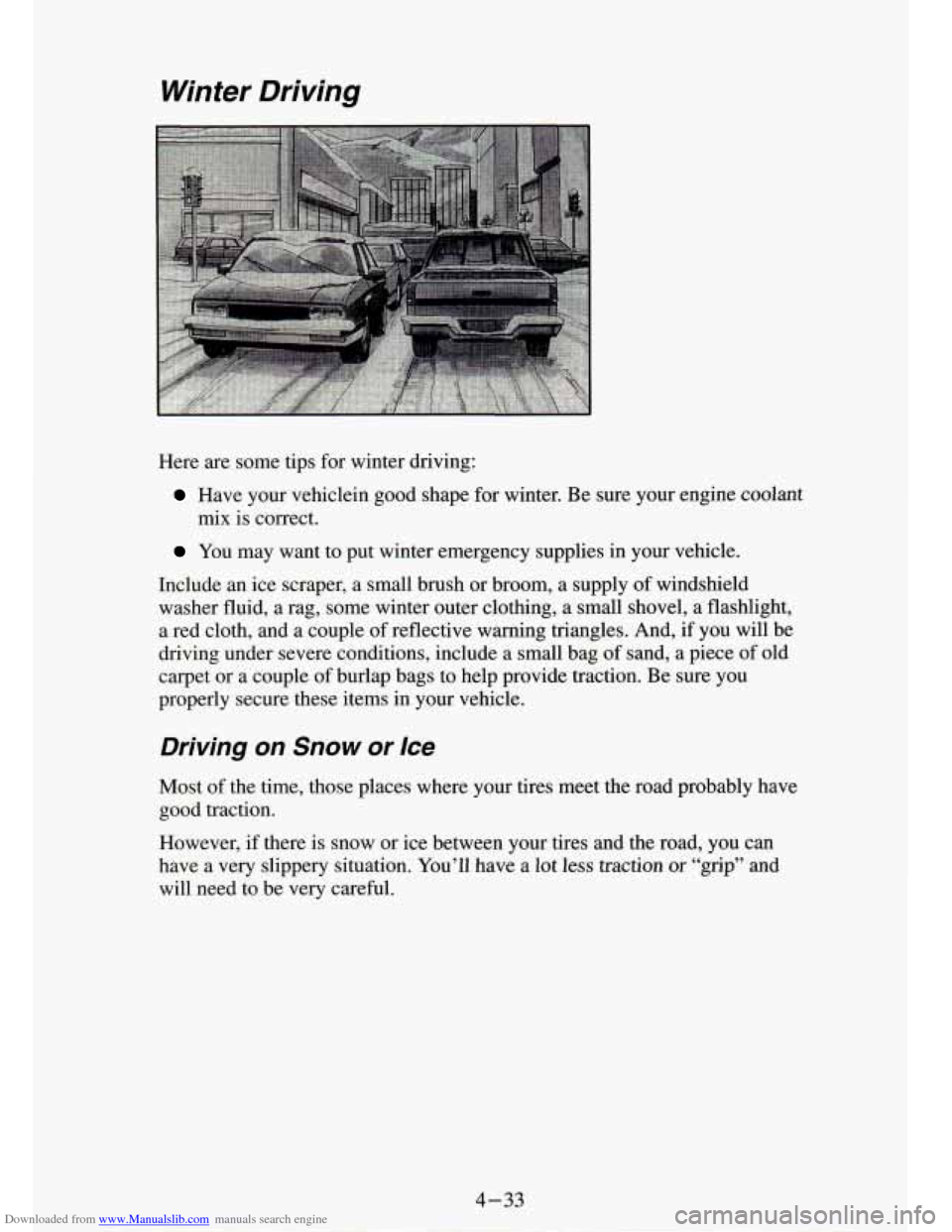
Downloaded from www.Manualslib.com manuals search engine Winter Driving
Here are some tips for winter driving:
Have your vehiclein good shape for winter. Be sure your engine coolant
You may want to put winter emergency supplies in your vehicle.
mix is correct.
Include an ice scraper, a small brush or broom, a supply of windshield
washer fluid, a rag, some winter outer clothing, a small shove\
l,
a flashlight,
a red cloth, and a couple
of reflective warning triangles. And, if you will be
driving under severe conditions, include a small bag
of sand, a piece of old
carpet or a couple of burlap bags to help provide traction. Be sure you
properly secure these items in your vehicle.
Driving on Snow or Ice
Most of the time, those places where your tires meet the road probably\
have
good traction.
However, if there is snow or ice between your tires and the road, you can
have a very slippery situation. You’ll have a lot less traction or “grip” and
will need to be very careful.
4-33
Page 184 of 340
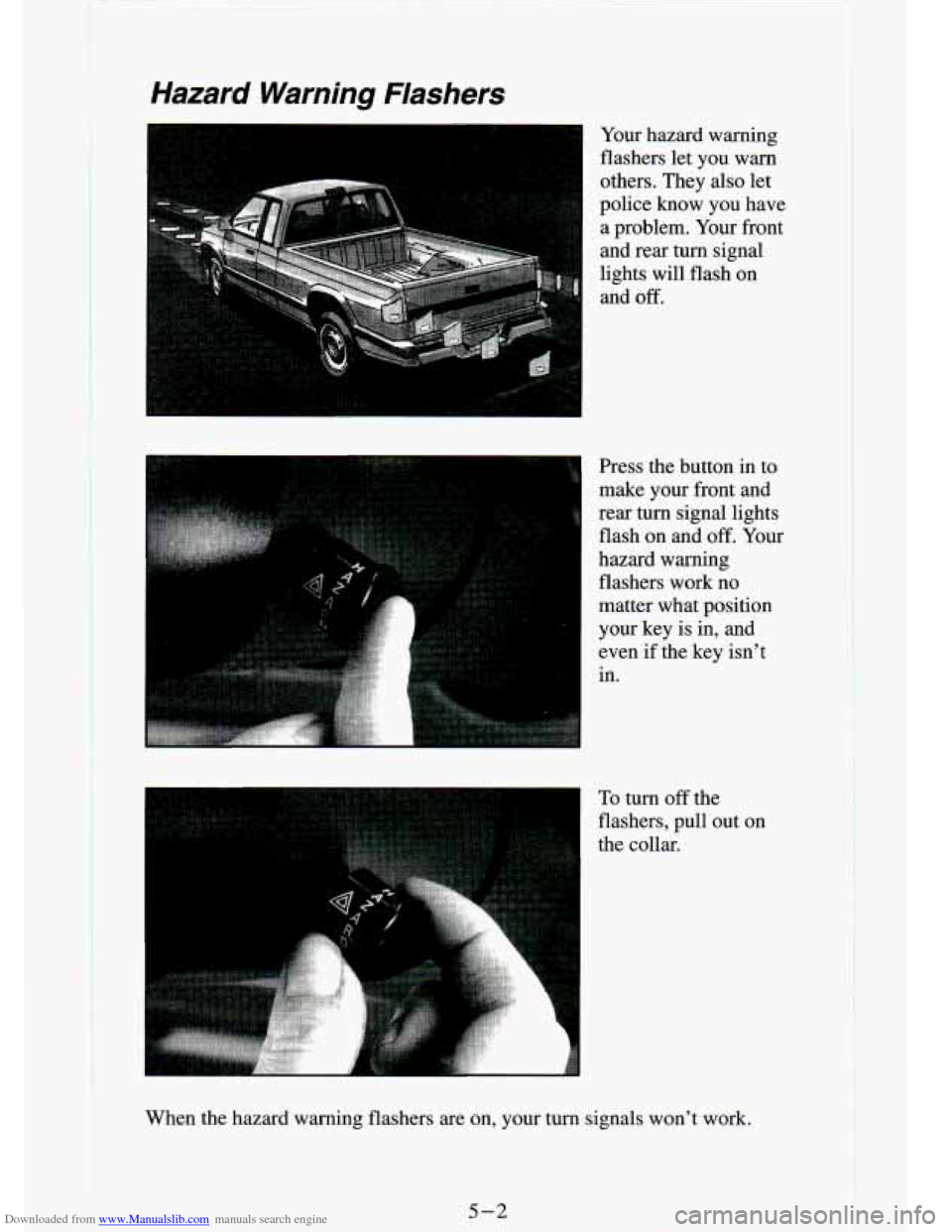
Downloaded from www.Manualslib.com manuals search engine Hazard Warning Flashers
-1 Your hazard warning
flashers let you warn
others. They also let
and
off.
I police know you have a problem. Your front
and rear turn signal
lights will flash on
Press the button in to
make your front and
rear
turn signal lights
flash on and off. Your
hazard warning
flashers work no
matter what position
your key is in, and
even if the key isn’t
in.
To turn off the
flashers, pull out
on
the collar:
When the hazard warning flashers are
on, your turn signals won’t work.
Page 241 of 340
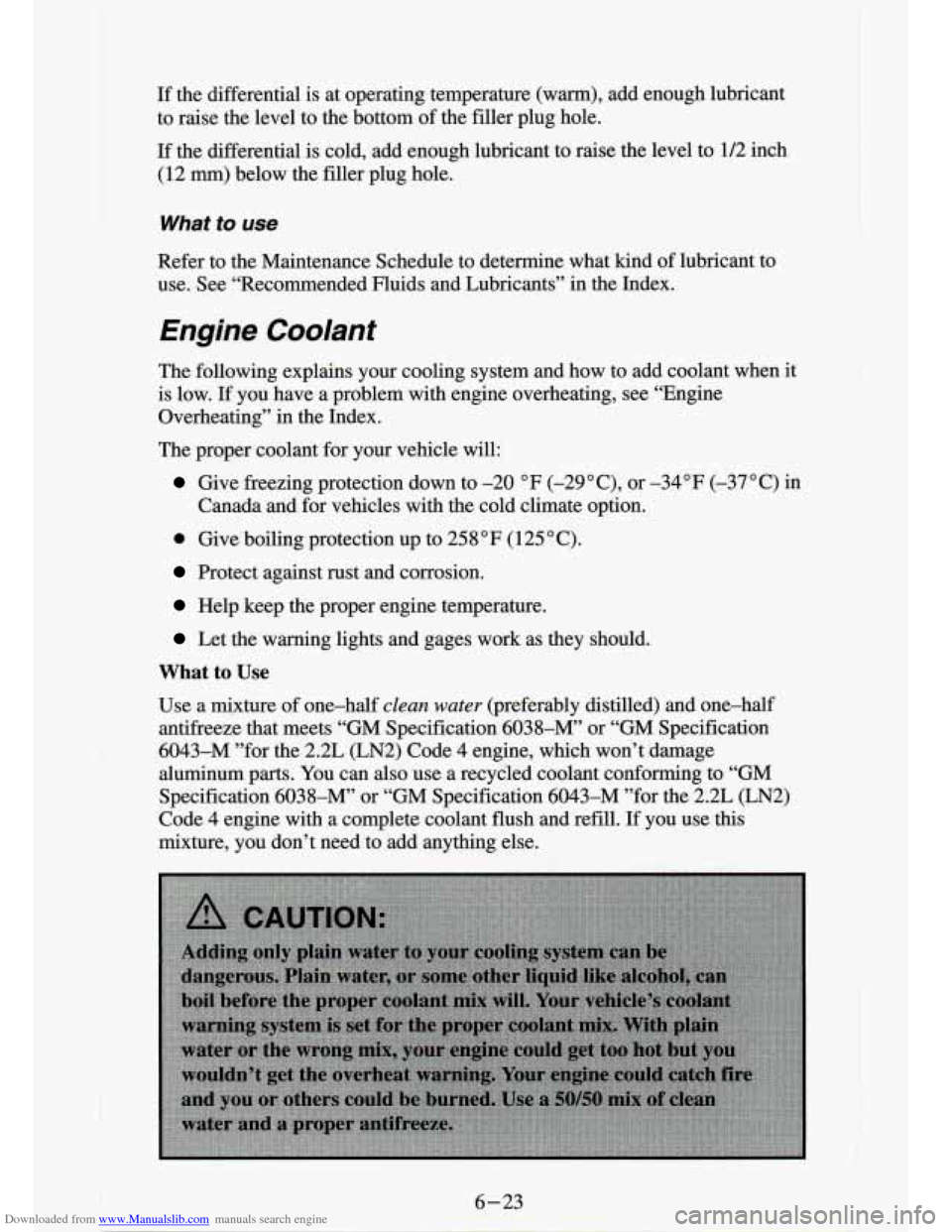
Downloaded from www.Manualslib.com manuals search engine If the differential is at operating temperature (w,arm), add enou\
gh lubricant
to raise the level to the bottom of the filler plug hole.
If the differential is cold, add enough lubricant to raise the level to 1/2 inch
(12
mm) below the filler plug hole.
What to use
Refer to the Maintenance Schedule to determine what kind of lubricant to
use. See “Recommended Fluids and Lubricants” in the Index.
Engine Coolant
The following explains your cooling system and how to add coolant \
when it
is low.
If you have a problem with engine overheating, see “Engine
Overheating” in the Index.
The proper coolant for your vehicle will:
Give freezing protection down to -20 “F (-29” C), or -34°F (-37 “C) in
Canada and for vehicles with the cold climate option.
e Give boiling protection up to 258°F (125°C).
Protect against rust and corrosion.
Help keep the proper engine temperature.
Let the warning lights and gages work as they should.
What to Use
Use a mi,xture of one-half clean water (preferably distilled) and one-half
antifreeze that meets “GM Specification 603%” or “GM Specification
6043-M ”for the 2.2L (LN2) Code 4 engine, which won’t damage
aluminum parts. You can also use
a recycled coolant conforming to “GM
Specification 603%” or “GM Specification 6043-M ”for the 2.2L (LN2)
Code 4 engine with a complete coolant flush and refill.
If you use this
mixture, you don’t need to add anything else.
6-23
Page 249 of 340
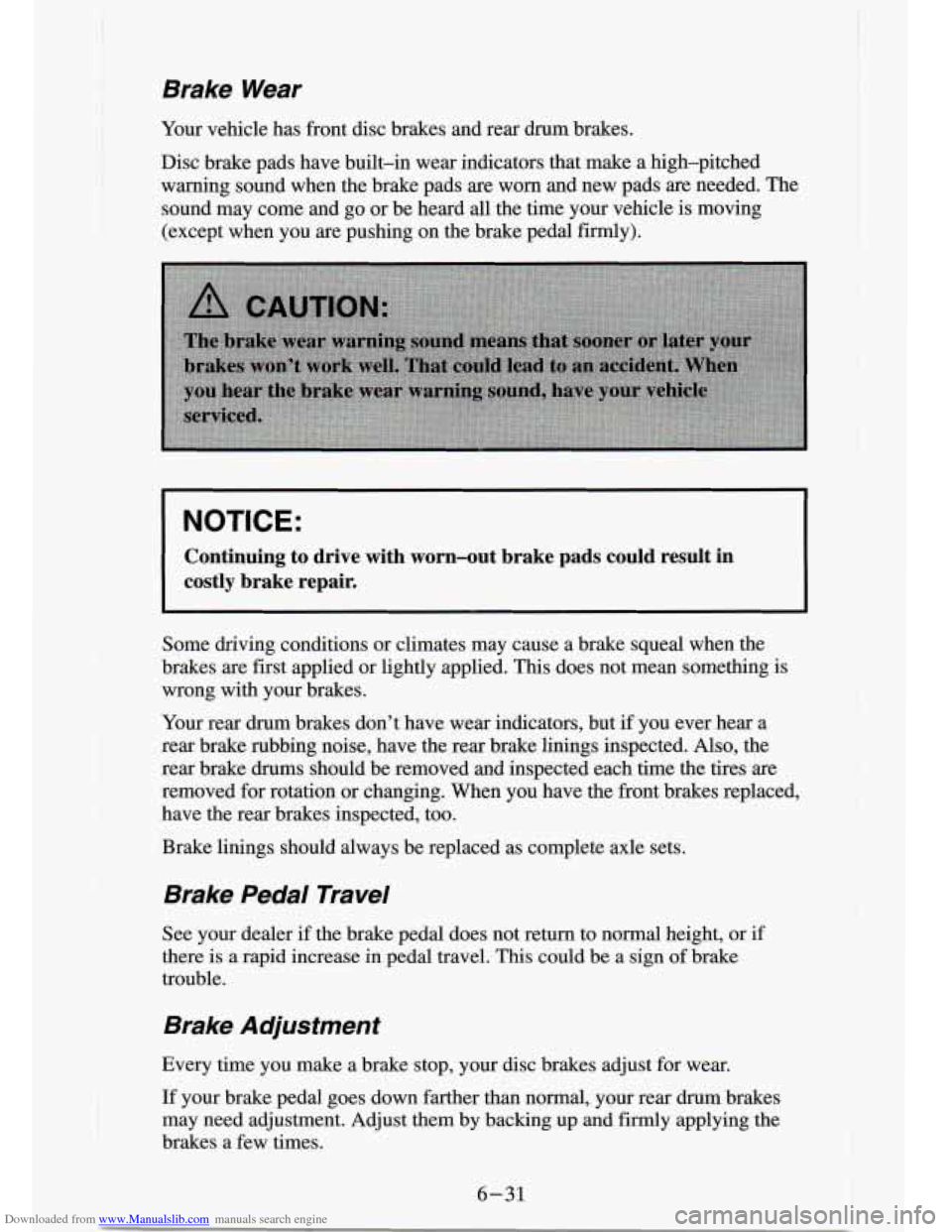
Downloaded from www.Manualslib.com manuals search engine Brake Wear
Your vehicle has front disc brakes and rear drum brakes.
Disc brake pads have built-in wear indicators that make a high\
-pitched warning sound when the brake pads are worn and new pads are \
needed. The
sound may come and go or be heard
all the time your vehicle is moving
(except when you -are pushing on the brake pedal
firmly).
I NOTICE:
I
Continuing to drive with worn-out brake pads could result in
costly brake repair.
Some driving conditions or climates may cause a brake squeal w\
hen the
brakes are first applied or lightly applied. This does not mean something is
wrong with your brakes.
Your rear
drum brakes don’t have wear indicators, but if you ever hear a
rear brake rabbing noise, have the rear brake linings inspected. Also, the
rear brake drums should be removed and inspected each time the\
tires itre
removed for rotation or changing. When you have the front brakes replaced,
have the rear brakes inspected, too.
Brake linings should always be replaced
as complete axle sets.
Brake Pedal Travel
See your dealer if the brake pedal does not return to normal height, o\
r if
there is a rapid increase in pedal travel. This could be a sign of brake
trouble.
Brake Adjustment
Every time you make a brake stop, your disc brakes adjust for wear.
If your brake pedal goes down farther than normal, your rear drum brakes
may need adjustment. Adjust them by backing up and
firmly applying the
brakes a few times.
6-31
Page 327 of 340
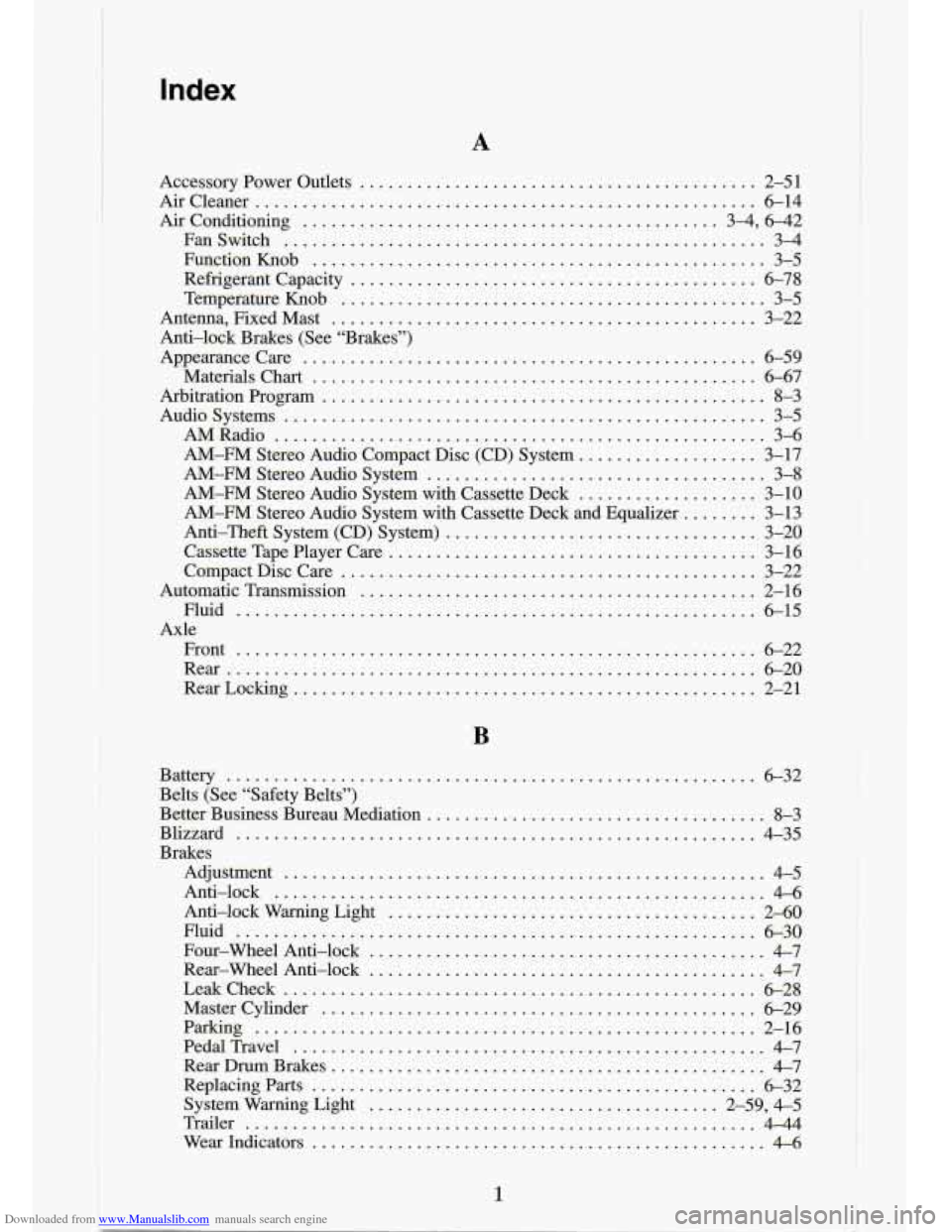
Downloaded from www.Manualslib.com manuals search engine Index
A
Accessory rower Outlets .......................................... 2-51
Aircleaner ..................................................... 6-14
Airconditioning
............................................ 3-4. 6-42
Fanswitch
................................................... 34
Functionhob
................................................ 3-5
Refrigerantcapacity
........................................... 6-78
Antenna. FixedMast
............................................. 3-22
Anti-lock Brakes (See “Brakes”)
Appearancecare
................................................ 6-59
Materials
Chart ............................................... 6-67
Arbitration Program
............................................... 8-3
Audiosystems
................................................... 3-5
AMRadio
.................................................... 3-6
AM-FM Stereo Audio Compact Disc (CD) System
................... 3-17
AM-FM Stereo Audio System
.................................... 3-8
AM-FM Stereo Audio System with Cassette Deck
................... 3-10
AM-FM Stereo Audio System with Cassette Deck and Equalizer ........ 3-13
Anti-Theft System (CD) System)
................................. 3-20
Cassette Tape Player Care
....................................... 3-16
CompactDiscCare
............................................ 3-22
Automatic Transmission
.......................................... 2-16
Axle Fluid
6-15
Front
....................................................... 6-22
Rear
........................................................ 6-20
Temperature Knob
............................................. 3-5
.......................................................
RearLocking ................................................. 2-21
B
Battery ........................................................ 6-32
Belts (See “Safety Belts”)
Better Business Bureau Mediation
.................................... 8-3
Blizzard
....................................................... 4-35
Brakes
Adjustment
................................................... 4-5
Anti-lock
.................................................... 4-6
Anti-lock Warning Light
....................................... 2-60
Fluid
....................................................... 6-30
Four-wheel Anti-lock
.......................................... 4-7
Rear-Wheel Anti-lock
.......................................... 4-7
Leakcheck .................................................. 6-28
Mastercylinder
.............................................. 6-29
Pedal Travel
.................................................. 4-7
RearDrumBrakes
.............................................. 4-7
Replacingparts
............................................... 6-32
System Warning Light
..................................... 2.59. 4-5
Trailer ...................................................... 444
Wear Indicators
................................................ 4-6
Paking
..................................................... 2-16
Page 332 of 340
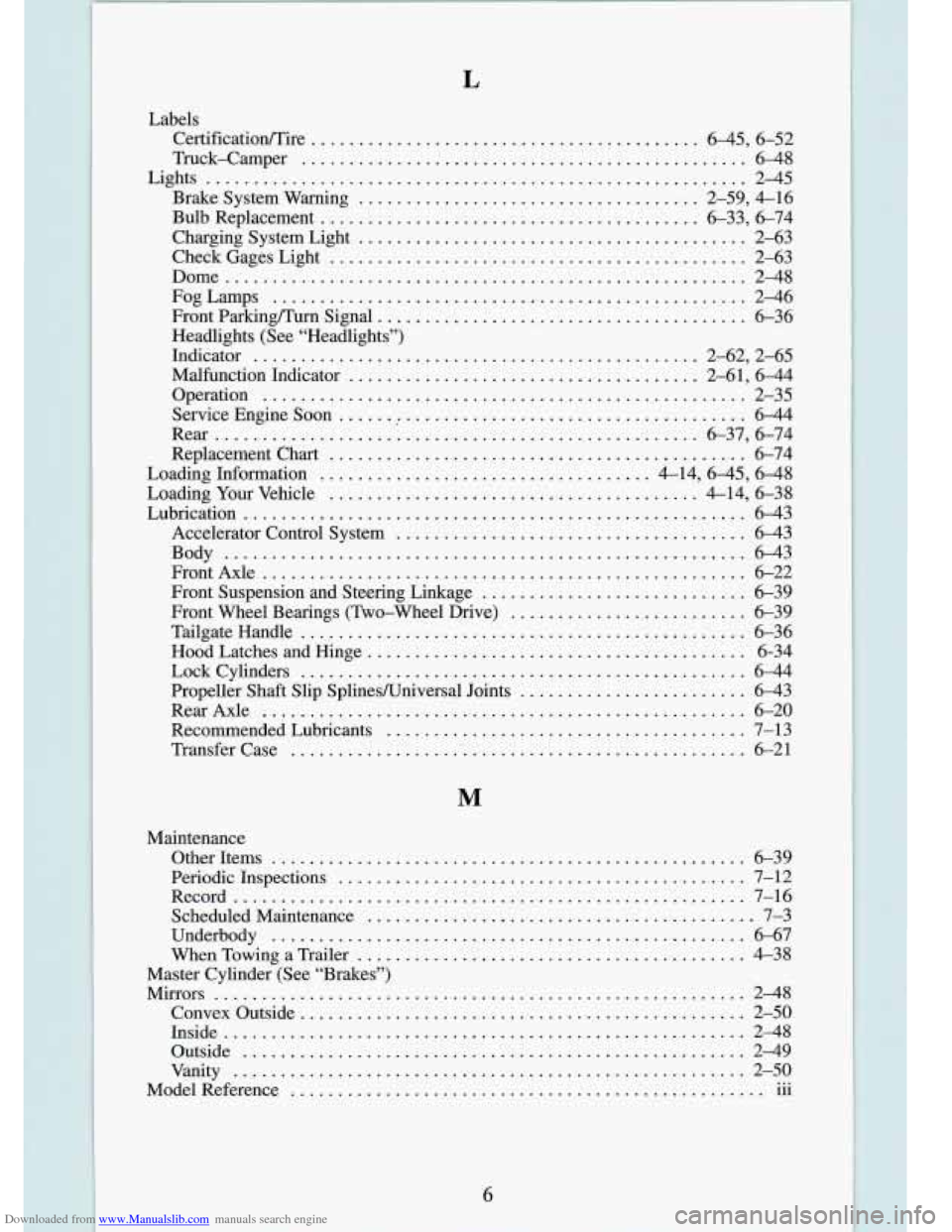
Downloaded from www.Manualslib.com manuals search engine L
Labels CertificatiodI‘ire
......................................... 6-45. 6.52
Truck-Camper
............................................... 6-48
Lights
......................................................... 2-45
Brake System Warning
.................................... 2.59. 4-16
Bulb Replacement
........................................ 6.33. 6-74
Charging System Light
......................................... 2-63
CheckGagesLight
............................................ 2-63
Dome
....................................................... 2-48
FogLamps
.................................................. 2-46
Front ParkingEurn Signal
....................................... 6-36
Headlights (See “Headlights”)
InQcator
............................................... 2.62. 2.65
Malfunction Indicator
..................................... 2.61. 6-44
Operation
................................................... 2-35
ServiceEngineSoon
........................................... 6-44
Rear
................................................... 6-37, 6-74
Replacement Chart
............................................ 6-74
Loading Information
................................... 4-14,645, 6-48
Loading Your Vehicle
....................................... 4-14, 6-38
Lubrication
..................................................... 6-43
Accelerator Control System
..................................... 6-43
Body
....................................................... 6-43
FrontAxle
................................................... 6-22
Front Suspension and Steering Linkage
............................ 6-39
Front Wheel Bearings (Two-Wheel Drive)
......................... 6-39
TailgateHandle
............................................... 6-36
HoodLatchesandHinge
........................................ 6-34
Lock Cylinders
............................................... 6-44
Propeller Shaft Slip SplinesNniversal Joints
........................ 6-43
RearAxle
................................................... 6-20
RecommendedLubricants
...................................... 7-13
Transfer Case
................................................ 6-21
M
Maintenance OtherItems
.................................................. 6-39
Record
...................................................... 7-16
ScheduledMaintenance
......................................... 7-3
Underbody
.................................................. 6-67
WhenTowingaTrailer
......................................... 4-38
Master Cylinder (See “Brakes”) Mirrors
........................................................ 2-48
Convexoutside
............................................... 2-50
Inside
....................................................... 2-48
Outside
..................................................... 2-49
Vanity
...................................................... 2-50
ModelReference
.................................................. 111
Periodic Inspections ........................................... 7-12
...
6